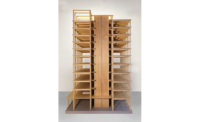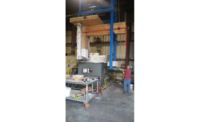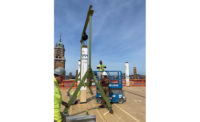Risk is no stranger to the Ukraine-born developers of the 284-ft-tall Ascent residential project—on deck to take mass-timber construction to record heights. In December 1989, when Ukraine was still part of the Soviet Union, Boris Gokhman and his son, Tim, then 10 years old, pretended they were going to Israel but instead fled to the U.S. The daring journey toward a better life in the “new land” was rife with uncertainties, unknowns and the unfamiliar.
“Anti-Semitism is one of the main reasons we left,” says Tim Gokhman, managing director of New Land Enterprises, which is developing the 25-story Ascent, despite the risks associated with the first use of the green building material in a U.S. tower. “My father was an engineer but he knew that, mainly because he was Jewish, his prospects were limited regardless of his ability,” explains Gokhman, whose father declined to be interviewed.
After gaining U.S. political asylum in Vienna and stopping in Italy, father and son landed in Milwaukee on March 8, 1990. Boris had selected the city because his business partner Walter Shuk, co-founder of New Land, had recently settled there.
Perhaps the most unnerving part of the Gokhman immigration scheme was that they had to leave Tim’s mother Raisa behind in Donetsk. “The Soviet Union had a practice of splitting family visas,” says Gokhman. She managed to join them that fall.
These early experiences had profound and lasting impacts on the Gokhman’s only child. Specifically, the trek gave him a high tolerance for risk. “Big challenges don’t phase me,” he says.
“In a business deal, what’s the grand consequence” of failure? Gokhman asks. “You are not going to prison or going to go hungry.”
Ascent epitomizes business risk. In the U.S., there were no precedents for the development, finance, insurance, design, approval, permitting, detailing, materials procurement, fabrication and construction of a timber frame that would exceed— by nearly 200 ft—the 85-ft height allowed by code. That didn’t stop the Gokhmans, who became hooked on the idea of architecturally expressed tall timber as a market differentiator, based on wood’s inherent beauty and its cache as a material that sequesters carbon.
Still, becoming a tall-timber role model wasn’t easy. “Had we known all the challenges in advance, we probably wouldn’t have started” the project, says Gokhman.
After arriving in Milwaukee, Boris Gokhman joined Shuk, painting houses for $4.15 an hour. Soon, they started a house-painting business. Then, they began dabbling in real estate. In 1993, they formed New Land. “Seeing what my father accomplished without money and language puts most other things in perspective,” says Gokhman.
Eventually, Boris Gokhman started innovating. He was the first in Milwaukee to use light-gauge steel framing in residential high-rises, and the first to use hydronic radiant-floor heating.
Tim joined New Land in 2002, soon after college. Though his father is active on jobsites, Tim became the face of New Land a decade ago. The Gokhmans are “audacious,” says Jason Korb, principal architect of Korb + Associates Architects, which designed the hybrid timber and concrete project with structural engineer Thornton Tomasetti.
New Land also was the first to develop a micro-unit residential building. “The Gokhmans are always finding a niche or filling a hole in the marketplace,” says Adam M. Arndt, president of Catalyst Construction, which is responsible for Ascent’s fit-out.
The high-rise, which will have 19 residential levels sitting on a six-story structural concrete parking podium, is set for completion July 1, 2022. No timber is expected on site until the spring. Still, New Land and Milwaukee—with its developer-friendly approvals process—have likely cleared a path for other tall timber towers in the U.S.







Post a comment to this article
Report Abusive Comment